Back in 2018, Gartner ran a survey to uncover the secrets of the buyer's journey. They learned that buyers got approximately 60% of the way to a purchasing decision before they engaged with the sales department.
Fast forward to 2021, they redid the survey and found that buyers were now 80% of the way through the purchasing decision before they spoke to a salesperson.
That leaves precious little time for the sales team to influence their choice. We fully expect that trend to continue, and that means your marketing and your brand are more important than ever.
In this article, I'll focus on:
- The typical buyer's journey,
- Getting to know your sales prospects,
- Multiple personas in the purchasing process,
- Building buyer personas,
- Putting the knowledge to work,
- The buyer’s journey, and
- Tracking persona engagement.
What is the typical buyer's journey?
Let’s start by taking a look at a typical buyer’s journey today.
Step one: Identification
This is the point at which a company identifies and decides to invest in a solution in order to reach its goals.
As an example of the kind of timeframe you could be looking at here, my company just decided to replace its existing CRM with Salesforce; between discussions about how the old CRM was not meeting our needs and the resolution to invest in a new solution, this step took over a year.
Step two: Research
Once potential customers have identified a problem and decided they need to spend some money to solve it, they enter the research phase, where they gather information on all the potential solutions they could invest in.
Step three: Intent
Next, customers compare the data they’ve gathered on potential solutions to figure out which solution is going to meet not only their needs but also their budgets.
Step four: Purchase
From there, they make the decision to buy. Now it’s time to negotiate prices, payment timeframes, and so on.
Step five: Implementation
Finally, once customers have signed on the dotted line, the solution needs to get ramped up and launched so that the entire company can use it.
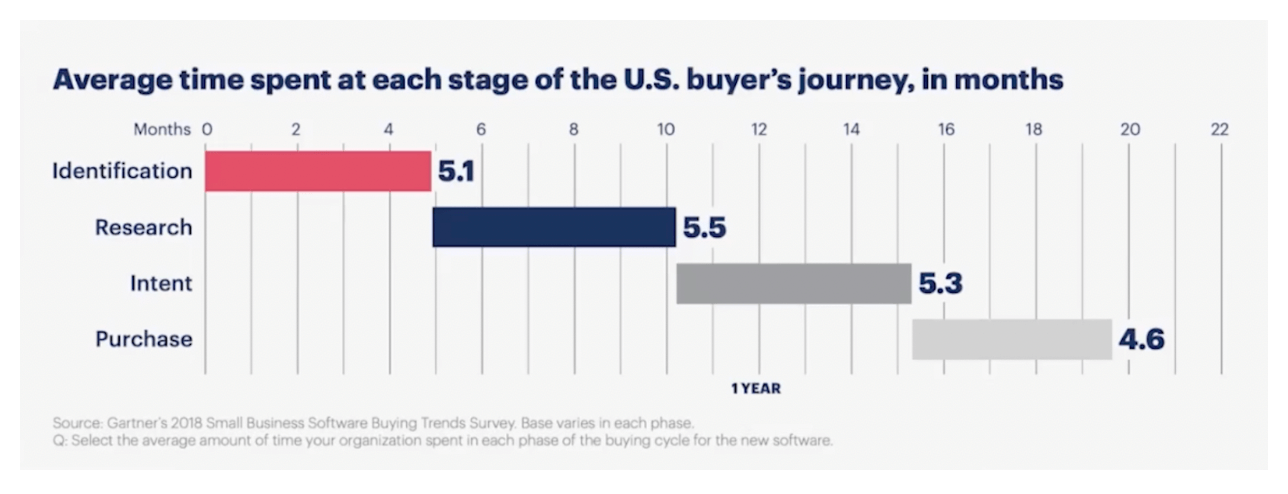
This process, from identification to being ready to implement the solution takes, on average, about 20 months.
In 2018, your sales department had about eight of those 20 months to influence the decision. By 2021, that had dropped to only four months. That means that today, more than three-quarters of the buyer’s journey has to be led by marketing.
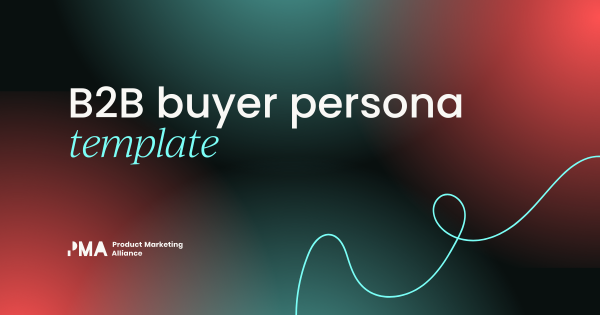
Getting to know your sales prospects
For marketing to guide the buyer’s journey, it has to know what makes the buyers tick.
That’s where persona research comes in. There is a ton of categories that you're going to want to ask about – everything from demographics to pain points to buying criteria.
For each category, the Product Marketing Alliance has provided a nice long list of questions to ask your prospects in order to understand them.
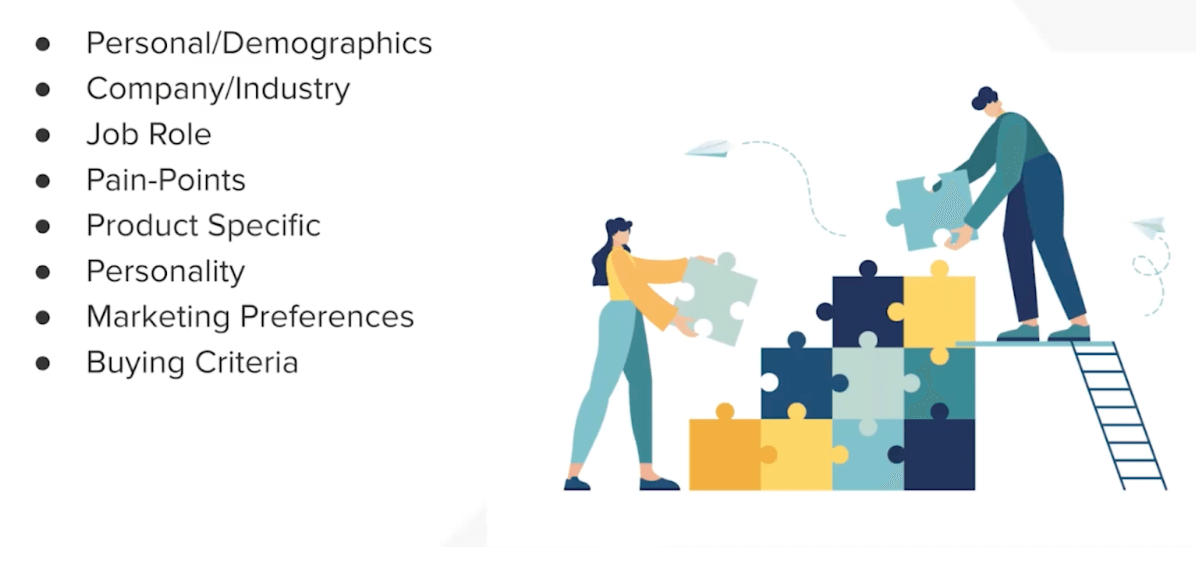
I'm sure you’re wondering where in the world we start with all this. My first piece of advice is to look at the categories and assess them. You want to make sure that the questions you ask your buyers relate to your business, so be sure to customize them to reflect what's important.
Once you've identified the categories that you want to understand, it’s time to evaluate the questions.
There's a laundry list of questions for each category, so you need to prioritize the most important questions for your company, product marketing team, and marketing department. Then, you'll see the list go from 20–30 to 10–15 questions for each category – a much more manageable number.
Now it’s time to interview your current customers. They’ve already gone through the buying process, so who better to talk to? Pick up the phone, set up an interview, and start walking through those questions. You'll be amazed at what you learn.
Multiple personas in the purchasing process
Once you've started interviewing your customers, you might find that there are multiple personas involved in the buying proces. A few key personas are the decision-maker, the evaluator, the influencer, and the champion. You also have the person that holds the purse strings and your end user to consider.
So why is this important? Well, you're going to find that different personas engage at different points along the buyer’s journey.
Your evaluator might be engaging early on in that journey because they have been tasked with figuring out what solutions are out there. They might be signing up for product trials so they can evaluate which solution is going to be best for their company.
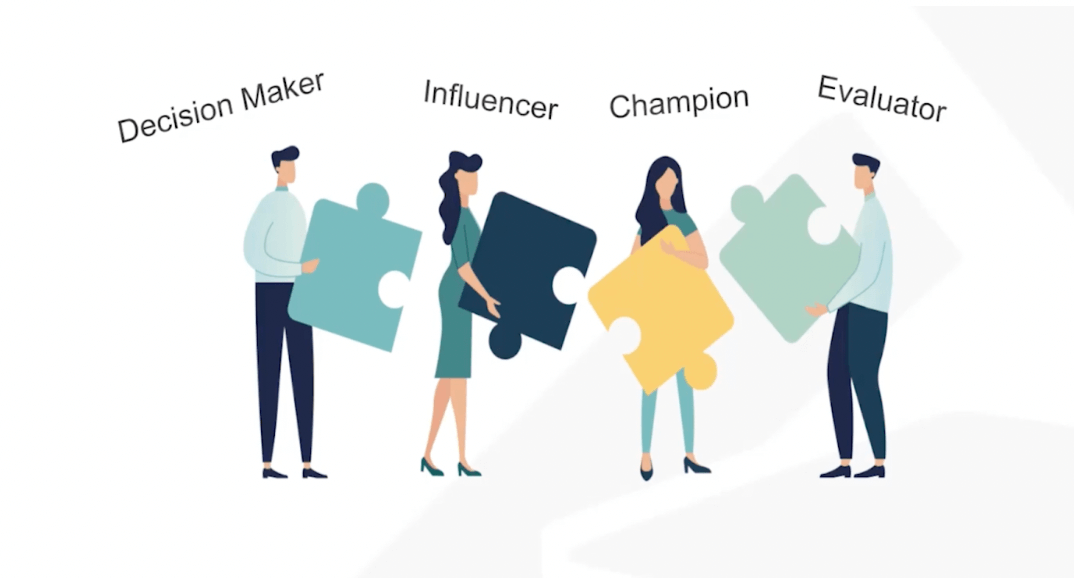
These personas are not set in stone. For instance, depending on how the trial process goes, the evaluator might become your champion and evangelize your product to the rest of the buyers involved in the process.
At Accusoft, we sell to a developer market. Our evaluators are developers. Our influencers are developers. Our champions are developers too. If you have a developer audience, they can embody several personas in the buyer's journey, and the decision-maker is usually their manager or the executive above them.
Building B2B buyer personas
Now that you’ve interviewed your customers and figured out who is involved in your buyer’s journey, it’s time to take all that information and amalgamate it into a persona that’s representative of your ideal buyer.
You're going to do this for each persona involved in your product’s buying process. Let’s look at an example.
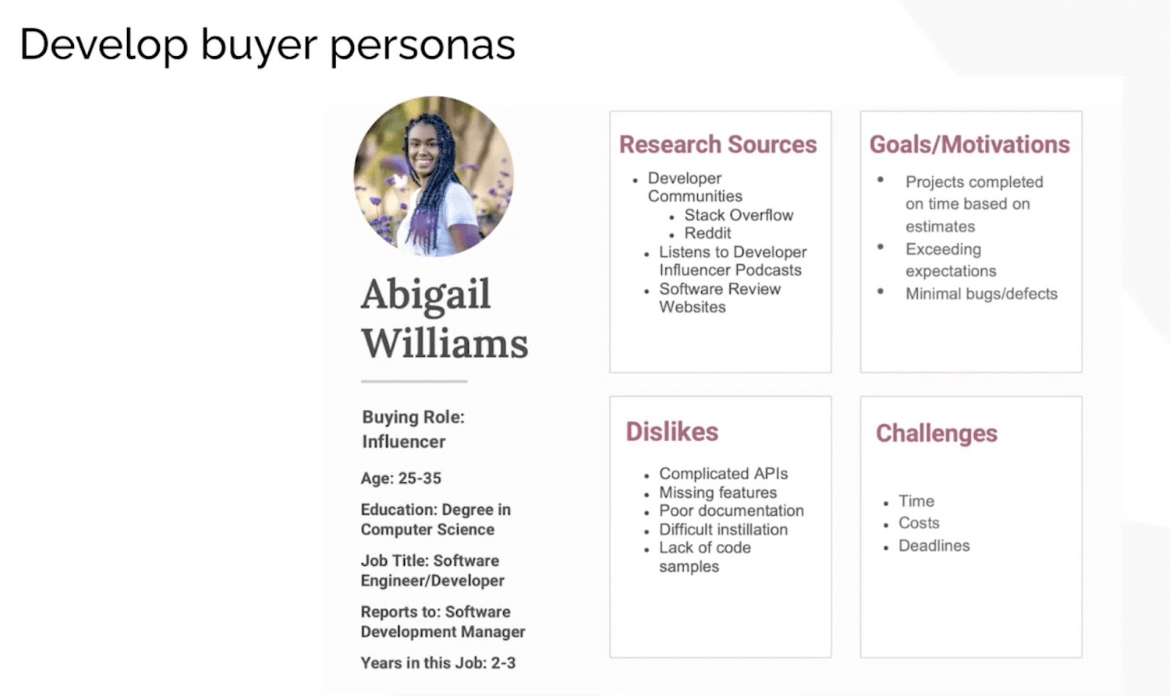
This is Abigail. She’s a software developer aged 25 to 35 and she plays an influencer role in the buying process. You can see her likes, dislikes, challenges, and what motivates her. You can also see where she goes to research and learn about products.
This is crucial because developers don’t typically like to be marketed to, so if you can share helpful content on their favorite platforms, you have a much better chance of getting through to them.
The amalgamation of your ideal persona is important to every single aspect of your company – marketing, product marketing, product development, sales, and accounts included – so once you've got your buyer personas down, you're going to socialize them internally.
This is going to help all your stakeholders to be more knowledgeable about what to expect during the buyer's journey, as well as the buyer's expectations of your company.
Putting the knowledge to work
So how do we put all this knowledge to work? On the product marketing side of things, our goal is to use all this information to build messaging that resonates.
Buyers want information that is relevant to them. They want materials that raise their awareness of the solutions that are available in the market. They're looking for a brand that they can trust, so building thought leadership materials is key.
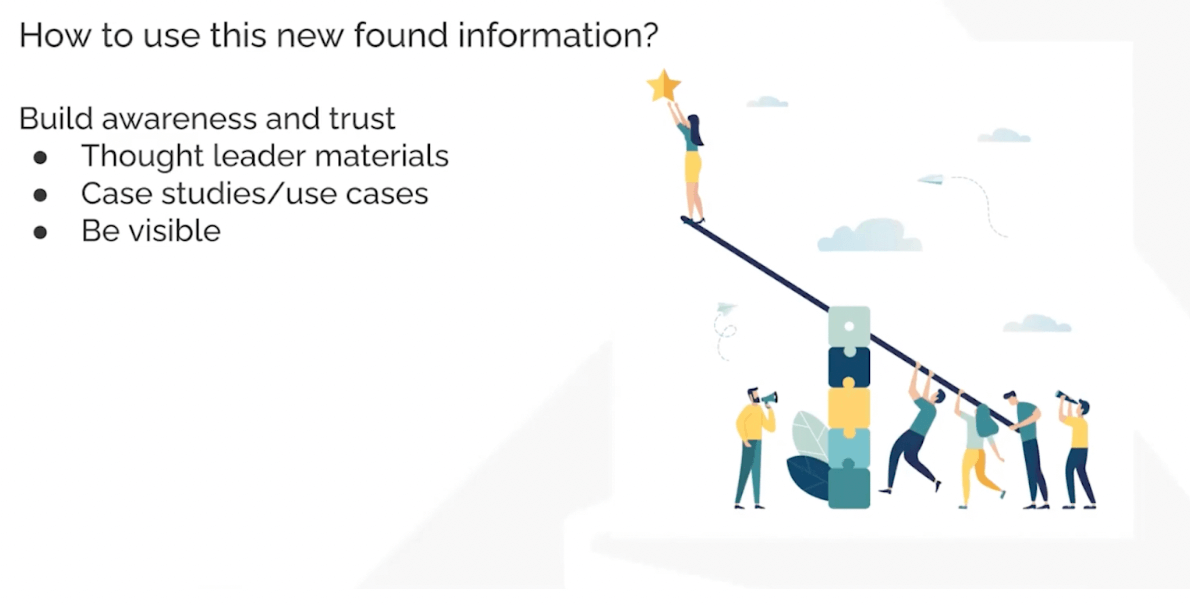
The developer audience is going to benefit from more technical materials that talk about how you implement your solution to solve their problems. They're looking for case studies about companies like theirs that have bought and loved your product – those are the best recommendations.
Often, developers can’t be involved in case studies because they don't want to admit to the world that they have a third-party solution embedded in their product.
In those scenarios, we talk about the pain point that brought that customer to Accusoft and how we helped them solve it, all without revealing who the customer is.
You've gathered knowledge about where your personas go to get their information, whether that’s Facebook, YouTube, or Stack Overflow – you want your brand to be visible there.
You want your potential customers to be aware of your brand and its use case from the very beginning of the buyer’s journey, while they’re identifying a pain point and deciding to invest in a solution.
Salesforce is a great example of this. Everybody's heard of Salesforce long before they ever interface with the application. Their brand is so well known that when companies are looking for a new CRM solution, the first thing they do is check out Salesforce.
The buyer’s journey
At this point, you’ve got a wealth of information about your buyers, you’ve created thought leadership content and case studies and use cases, and you've jazzed up your website so that it's all resonating with the right messaging. Now we get into the actual journey.
Fair warning: the buyer's journey can look like a bowl of spaghetti. They might start researching the product on your website, then sign up for a trial, then go back to the documentation to check the capabilities, and then ping questions through your website’s chat function. It can get very, very complicated, but don’t worry – we're going to break it down.
To make mapping your buyer journeys less overwhelming, start with just one persona. Let's take the influencer – what journey do you want them to take? Perhaps you want them to come through a search.
What keywords are you going to base your Google ads on? What’s the messaging on the landing page? Where's your CTA going to take them? You need to map that journey right down to the point at which the sales team steps in and closes the opportunity.
You’re probably not going to map this perfectly right out of the gate, and that’s okay. Get it good enough, launch it, test it, and iterate. You need to uncover whether brand awareness is converting into sales opportunities.
If you see that people are falling out along the journey and you’ve got their contact information, why not reach out and find out what happened?
It could be as simple as not finding the answer to a question they had while trying to build a proof of concept. That's valuable information. You could write a blog post or modify your documentation to answer their question. Better still: do both. That will help more people to continue on their buying journey.
Tracking persona engagement
Now you’ve mapped the buyer’s journey for each persona and you’ve created Google ads to target them at the right moment, you’re probably wondering how you’ll know who exactly is engaging with those ads. We're tackling the same challenge at Accusoft.
Our marketing department engages with two very distinct personas: the decision maker, who is usually the product owner or problem owner, and the influencer, who is usually a developer.
With this in mind, we've created landing pages for our Google ads to point to, and we’ve got two distinct CTA buttons on these pages – one inviting product owners to book a chat, and one inviting developers to start a free trial.

We're watching the engagement on these two buttons very closely. That's going to help us figure out whether more developers or product owners are coming to us through our Google ads, and that will influence our future marketing.
Key takeaways
Let’s wrap up with some key takeaways.
- The buyer's journey starts long before engagement, so make sure your brand is visible to your potential buyers, wherever they are.
- Make sure the marketing team understands your buyer personas and uses them to guide ad placement.
- Build your buyer's journey, then test it and iterate. Nothing's perfect. Everything is subject to change, and that's okay. A lot of marketing is a lot about throwing things against the wall and seeing what sticks, and your buyer’s journey is no different.
This article is based on a presentation by Tracy Schlabach, Director of Marketing at Accusoft, at the Masters of Product Marketing in October 2022. At the time of the presentation, she was Head of Marketing at the same company. Catch up on this presentation and others, using our OnDemand service.


















 Follow us on LinkedIn
Follow us on LinkedIn




.svg?v=1461f28f41)